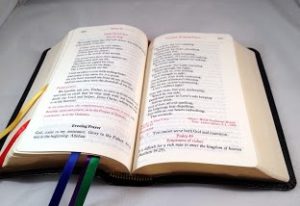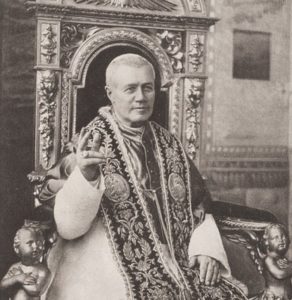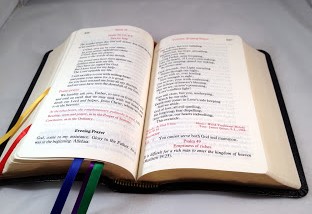 I have been asked by a number of people what I think of Pope Francis’ recent decision to remand a lot of the task of translating sacred texts to regional bishops’ conferences. To be honest, I have mixed feelings. On the one hand, I share many of the concerns about how the norms will be applied and how consistently accurate translations will be assured, but on the other, I do not know if it is healthy to place almost complete authority over the liturgy in Rome. In recent decades, many Catholics have depended on Rome to stamp out local liturgical abuses. Centralized authority is a double-edged sword, however. While some abuses have been addressed, there have also been many things imposed from Rome that those same Catholics have found far less pleasing.
I have been asked by a number of people what I think of Pope Francis’ recent decision to remand a lot of the task of translating sacred texts to regional bishops’ conferences. To be honest, I have mixed feelings. On the one hand, I share many of the concerns about how the norms will be applied and how consistently accurate translations will be assured, but on the other, I do not know if it is healthy to place almost complete authority over the liturgy in Rome. In recent decades, many Catholics have depended on Rome to stamp out local liturgical abuses. Centralized authority is a double-edged sword, however. While some abuses have been addressed, there have also been many things imposed from Rome that those same Catholics have found far less pleasing.
As a kind of an admonition in this regard, I would like to republish an article I wrote a few years ago. It describes an unusual tale, one with some strange twists and turns, that helps to illustrate the problems with a sometimes heavy-handed centralized authority versus a more regional exercise of authority. Finding a balance for the Church in all this is not easy. I don’t know all the implications of permitting greater regional influence over translations, but something tells me that that either solution has potential problems. Here this is the reprint:
In the modern struggles and disagreements over the Liturgy, there tends to be a list of friends and opponents depending on one’s stance. For those of us with a more traditional leaning, Pope St. Pius X looms large as a friend and an image of tradition. He is usually seen as a defender of tradition and a great proponent of what today is called the Extraordinary Form (EF) or Traditional Latin Mass (TLM)—so much so that the Society of St. Pius X (SSPX) takes its name from him.
Yet things, people, and movements are seldom as simple as we would like them to be. There are many good reasons for admiring Pope St. Pius X’s attention to the Sacred Liturgy, but it can also be argued that he helped lay the groundwork for the revolution that would follow, not so much by his ideas but by his rather sweeping use of papal authority to influence and change the liturgy in his day.
One of the most far-reaching things he did had little impact on the average Catholic but it had a dramatic effect on priests, because it made changes to the Breviary, the prayers said by priests each day in the Divine Office (or Liturgy of the Hours). What makes what he did so significant was his use of papal power to rather summarily effect the change, a change that arguably did away with almost 1500 years of tradition, just because he wanted to. I’ll provide more of the details later, but first here is a little background. (If you want to bypass the background information, skip ahead to the red text below.)
Background:
The Roman Rite of the Mass developed and came to fundamental form in the very early days of the Church. Its most basic elements were mature by the 5th century, though most of its elements date back far earlier. Due to the influence of the Roman See, it was largely the pure template for the liturgical practice of the Western Church. However, there were many local variations to the Roman Rite, some of them significant enough to permit the use of another name altogether (e.g., the Gallican Rite, the Ambrosian Rite, the Sarum).
This diversity of liturgical practice caused tension at times, if for no other reason than its bewildering complexity. From time to time there were attempts made to unify the liturgy throughout Europe by recourse to the Roman Rite and the fundamental purity and antiquity it was accorded. Most notably, the Council of Trent decreed that any form of the liturgy that was less than 200 years old should be suppressed in favor of the Rite as celebrated in Rome. There was a reverence for antiquity and a wariness of novelty and recent innovations.
Yet even after Trent, especially in places like France, there was a tendency for accretions and innovations. In a display of what has sometimes been called Gallicanism, the decrees of the Council of Trent were either ignored or enforced less and less strenuously. Thus many local variations began again to develop. By the 18th century, many liturgists began to critique the disorderly state of affairs and emphasized a kind of ultramontanism (a term meaning, literally, “beyond (or over) the mountains” and referring to Rome), which sought to establish the Roman Rite more purely.
By the time of the First Vatican Council (1869-70), papal influence was already well established from antiquity, but was also growing against Gallicanism and other local episcopal influence. Weariness over local European divisions was also part of the growing influence of the Pope. The Dogma of Papal Infallibility, proclaimed at the First Vatican Council (though narrowly construed and only invoked in very specific circumstances), served only to highlight papal power and influence.
Thus by the time of Pope Pius X (1903-1914), the “booster shot” that had been given to the papacy enabled him to flex his papal muscles and extend his influence in more sweeping ways. All this leads us to the liturgical changes introduced by Pope Pius X.
It was in 1911, with the publication of Divino afflatus, that rather dramatic changes were made to the Roman Breviary.
Some of the changes were small: cleaning up some accretions, adjusting the calendar, and giving greater priority to the temporal cycle over the more erratic sanctoral cycle. The obligations of what parts of the office and other prayers had to be said by priests were also clarified.
Along with these minor changes was a casting aside of the ancient arrangement of the psalter. Most notably, the ancient and almost universal tradition of praying the Laudate psalms (148-150) every morning and again every night at Compline was simply removed and replaced. No tradition in the Church was as universal and ancient as this, but with one stroke of his pen, Pope Pius X did away with it. Almost no liturgist has ever described what the Pope did as anything less than dramatic and sweeping.
Alcuin Reid, OSB, in his The Organic Development of the Liturgy (pp. 74-76), quotes the views of a number of liturgical scholars on this action by Pope St. Pius X:
- Anton Baumstark (in a scathing remark): Down to the year 1911 there was nothing in the Christian liturgy of such absolute universality as this practice in the morning office, and no doubt its universality was inherited from the Synagogue … hence, to [this “reform”] of Psalterium Romanun belongs the distinction of having brought to an end the universal observance of a liturgical practice which was followed by the Divine Redeemer himself during his life on earth.
- Pius Parsch: It is rather amazing that despite the conservative character of the Church, Pius X should have resolved on this vast change which went counter to a practice of 1500 years’ standing.
- Robert Taft, SJ: … this was a shocking departure from the almost universal Christian tradition.
- William Bonniwell, OP: In the revision of Pius X the venerable office of the Roman Church was gravely mutilated.
Frankly, Pius X’s move was unprecedented in liturgical history. Although Pope Urban VIII’s redaction of the Latin Hymns of the Breviary was also an unfortunate and imprudent mutilation of ancient masterpieces, their use in the Church was less universal than the psalms of Lauds and the redaction was not imposed by judicial power.
The issue may seem minor to those unfamiliar with the Office, but the precedent of using sweeping judicial power to simply end an ancient tradition is not minor at all. It is this same thinking that would later allow a sweeping change of the Mass to be promulgated in 1970 and for the Old Rite to be “abolished” by judicial fiat of Pope Paul VI. The Mass promulgated in 1970 was not specified by the Second Vatican Council Fathers, but by a small consilium. It was not marked by organic change but (as Pope Benedict XVI and others have observed) rather was characterized by a hermeneutic of rupture and discontinuity. Only later would Pope Benedict XVI teach that there was no precedent for or right to abolish the older form Roman Rite (a rite far older than 200 years).
 All of this heavy-handed use of papal power ironically had a precedent in Pope St. Pius X, the favored saint of many lovers of tradition. There were other liturgical waves that emanated from this indisputably good man and pope that have troubled us since. Among them was the disruption in the order of the Sacraments, when Pope Pius X moved First Communion to early youth but did not attend to the Sacrament of Confirmation. Thus the ancient order of initiation: Baptism, Confirmation, and Eucharist, was disrupted; Confirmation became a kind of “hanging” sacrament, detached from its liturgical and theological moorings. The result was its reduction to a sort of Catholic Bar Mitzvah.
All of this heavy-handed use of papal power ironically had a precedent in Pope St. Pius X, the favored saint of many lovers of tradition. There were other liturgical waves that emanated from this indisputably good man and pope that have troubled us since. Among them was the disruption in the order of the Sacraments, when Pope Pius X moved First Communion to early youth but did not attend to the Sacrament of Confirmation. Thus the ancient order of initiation: Baptism, Confirmation, and Eucharist, was disrupted; Confirmation became a kind of “hanging” sacrament, detached from its liturgical and theological moorings. The result was its reduction to a sort of Catholic Bar Mitzvah.
Further, Pope Pius X was also dismissive, if not juridically forbidding, of orchestral masses. While he fostered chant—a good thing—he also suppressed a musical form that had inspired most of the classical composers (e.g., Mozart, Schubert, and Beethoven) to contribute to the Church’s musical patrimony. It would be 70 years before such Masses would again be heard widely in the Church.
Again, all of these issues are less significant for their immediate effect than for the groundwork they laid for what came later. The sudden liturgical changes of the 1960s would not have been possible in previous ages because although the Pope and Rome were strongly influential, local bishops and churches had a lot more leeway and influence on the liturgy.
This setup of local freedom is not without troubles. Too much diversity leads to difficulty and chaos. Some general norms need to hold sway; regional and even ecumenical councils need to help rein in extreme diversity by reasserting proper liturgical principles.
However, centralizing power over the liturgy within the papacy also presents serious difficulties. Plainly put, the liturgy is just too important to have it all depend on the notions of one man, even a holy man like Pius X. Many of his reforms were good, even necessary, and his sanctity is not in dispute; but even saints do not get everything right and some of what they say and do may later be exaggerated or corrupted by those that follow.
In recent decades, traditional Catholics have looked to Rome to resolve liturgical debates. On one level this has been necessary, as many local bishops and churches have seemingly abdicated their responsibility to oversee the liturgy, correct abuses, and guarantee the legitimate rights of the faithful.
However, traditional Catholics would also do well to understand the problems inherent in having an overly centralized control of the Sacred Liturgy. More needs to be done by traditional Catholics to build a foundation for good liturgy in their local parishes by building a culture that is respectful of tradition and sober about the pitfalls of depending too much on papal authority.
How strange it is that the paragon of traditional Catholicism should have, even if unwittingly, helped paved the way for what I would argue is the excessive use of supreme judicial authority in regard to the liturgy, a use so sweeping that even Pope Benedict XVI would have to announce that the suppression of the older Roman Rite was neither possible nor in effect.
Just one of those strange moments in liturgical history.

